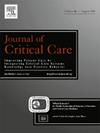Association of opioid utilization in the intensive care unit and opioid prescriptions at hospital discharge in opioid-naïve non-surgical patients who received enhanced oxygen therapy
IF 2.9
3区 医学
Q2 CRITICAL CARE MEDICINE
引用次数: 0
Abstract
Purpose
To evaluate the association between opioid utilization in community-based intensive care units and the continuation of opioid prescriptions at hospital discharge for non-surgical, opioid-naïve patients.
Materials and methods
This nested case-control study included adults without opioid prescriptions 45 days before hospital admission who had intensive care unit stays of 48 h or longer and received enhanced oxygen therapy. Patients were excluded if they had opioid allergies, cancer, in-hospital death, palliative care, major surgery, or substance use disorders. Opioid utilization was measured using cumulative oral morphine equivalents and average daily morphine equivalents during the intensive care unit stay. Multivariable regression models examined the association between opioid utilization and opioid prescription at discharge.
Results
Among 260 patients, 33 patients (12.7 %) received opioid prescriptions at discharge. These patients had significantly higher cumulative morphine equivalents during their intensive care unit stay (cases: 3362.4, standard error 1102.5; controls: 1024.9, standard error 240.0; p = 0.002) and higher average daily morphine equivalents during their stay (cases: 129.8, standard error 36.9; controls: 61.2, standard error 10.7; p = 0.03). Patients who received more than 90 cumulative morphine equivalents during their intensive care unit stay had 6.63 times higher odds of receiving an opioid prescription at discharge (p < 0.001). Each additional 10 daily morphine equivalents increased the odds of discharge continuation by 3 % (p = 0.011).
Conclusions
Increased opioid utilization during intensive care unit stays was associated with higher odds of opioid prescriptions at discharge in opioid-naïve, non-surgical patients.
Abstract key points
Question: Does opioid use in community-based ICUs correlate with continued opioid prescriptions at discharge for opioid-naïve, non-surgical patients?
Findings: This nested case-control study found that patients who received opioids during their ICU stay had a higher likelihood of being prescribed opioids at discharge. Specifically, those with cumulative opioid use >90 MME had 6.63 times higher odds of opioid continuation at discharge.
Meaning: The study concludes that higher opioid use during ICU stays significantly increases the likelihood of opioid prescription continuation at hospital discharge for opioid-naïve, non-surgical patients.
重症监护病房阿片类药物使用与opioid-naïve接受强化氧疗的非手术患者出院时阿片类药物处方的关系
目的评估社区重症监护病房阿片类药物使用与非手术opioid-naïve患者出院时阿片类药物处方延续之间的关系。材料和方法本巢式病例对照研究纳入入院前45天未开阿片类药物处方、在重症监护病房停留48小时或更长时间并接受强化氧疗的成年人。排除有阿片类药物过敏、癌症、院内死亡、姑息治疗、大手术或物质使用障碍的患者。在重症监护病房期间,使用累积口服吗啡当量和平均每日吗啡当量来测量阿片类药物的利用。多变量回归模型检验了阿片类药物使用与出院时阿片类药物处方之间的关系。结果260例患者中,33例(12.7%)在出院时获得阿片类药物处方。这些患者在重症监护病房期间累积吗啡当量显著增加(病例数:3362.4,标准误差1102.5;对照:1024.9,标准误差240.0;P = 0.002)和更高的平均每日吗啡当量(病例数:129.8例,标准误差36.9;对照:61.2,标准误差10.7;p = 0.03)。在重症监护病房住院期间接受超过90个累积吗啡当量的患者在出院时接受阿片类药物处方的几率高出6.63倍(p <;0.001)。每天每增加10个吗啡当量,继续出院的几率增加3% (p = 0.011)。结论:opioid-naïve非手术患者在重症监护病房期间阿片类药物使用率的增加与出院时阿片类药物处方的增加有关。问题:社区icu中阿片类药物的使用是否与opioid-naïve非手术患者出院时继续使用阿片类药物相关?研究结果:这项巢式病例对照研究发现,在ICU住院期间接受阿片类药物治疗的患者在出院时获得阿片类药物处方的可能性更高。具体而言,累计使用阿片类药物90 MME的患者在出院时阿片类药物继续使用的几率高出6.63倍。意义:该研究得出结论,ICU住院期间阿片类药物的使用增加了opioid-naïve非手术患者出院时阿片类药物处方延续的可能性。
本文章由计算机程序翻译,如有差异,请以英文原文为准。
求助全文
约1分钟内获得全文
求助全文
来源期刊

Journal of critical care
医学-危重病医学
CiteScore
8.60
自引率
2.70%
发文量
237
审稿时长
23 days
期刊介绍:
The Journal of Critical Care, the official publication of the World Federation of Societies of Intensive and Critical Care Medicine (WFSICCM), is a leading international, peer-reviewed journal providing original research, review articles, tutorials, and invited articles for physicians and allied health professionals involved in treating the critically ill. The Journal aims to improve patient care by furthering understanding of health systems research and its integration into clinical practice.
The Journal will include articles which discuss:
All aspects of health services research in critical care
System based practice in anesthesiology, perioperative and critical care medicine
The interface between anesthesiology, critical care medicine and pain
Integrating intraoperative management in preparation for postoperative critical care management and recovery
Optimizing patient management, i.e., exploring the interface between evidence-based principles or clinical insight into management and care of complex patients
The team approach in the OR and ICU
System-based research
Medical ethics
Technology in medicine
Seminars discussing current, state of the art, and sometimes controversial topics in anesthesiology, critical care medicine, and professional education
Residency Education.
 求助内容:
求助内容: 应助结果提醒方式:
应助结果提醒方式:


